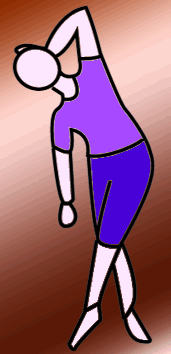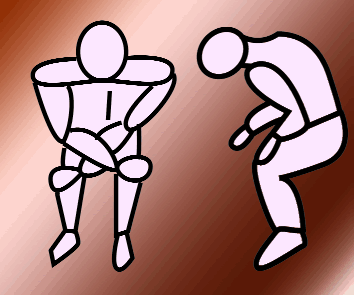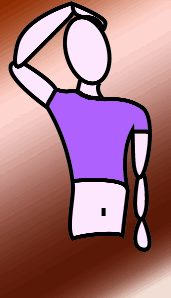Positive Health Online
Your Country

Case Study Issue 116: Deep Tissue Sports Massage
listed in case studies, originally published in issue 116 - October 2005
Personal Details
CC is a client who was referred to me by a local Osteopath. I also refer clients to the osteopath when I feel it is in the best interest of my client.
CC has a curvature and tightness of the spine causing a lot of pain. The Osteopath referred her to me to keep her musculature in better condition, making it easier to manipulate and to maintain improvements after Osteopathic treatment. I see CC on a regular basis; weekly or fortnightly.
CC is of a slim build and 5' 8" tall. She is a medical secretary at a local hospital and complains that she sits in a draft causing her neck to become tight and immobile. Her hobby and great passion/interest is dancing. She attends many dance classes several times a week. She also attends weekend events, doing dances from Jazz to Hip Hop. She also travels all over the country to attend classes taught by skilled dancers from America to Spain.
Condition
First treatment
Her presenting problem was her lower back which had just been corrected by the osteopath. The facet joint had been re-aligned. The area that I found to be in need of treatment was mainly around the lower and upper back and neck.
Range of Movement
On testing, the range of movement was limited in the lower back, but was worse in the neck. The lateral movement – side to side – of the neck was limited, restricting the turning, left and right. Extension and flexion of the neck was tight, but not limited to any great extent. Visually her shoulders were raised towards the ears indicating tight Trapezius muscles.
Treatment Plan
The aim was to release the tension in the muscles of the lower and upper back and neck using palpation to find tight areas and points of Micro Trauma. I treated using neuromuscular techniques and the following machines: G5, Audio sonic – Nova sound and Interferential – endoscan, to avoid excessive pain if and when found. I avoided cross fibre friction because it tends to lead to further inflammation, pain and excessive soreness, interfering with on-going training and competition. Finally I used a Proprioceptive Neuromuscular Facilitation (PNF) muscle energy stretch to correct the tightness and to improve the muscle length. This stretch also ensures that the trauma eradication lasts longer and improves the range of movement (RoM) of the joint.
Details and Results
With the body in a prone position, I warmed the musculature of the back, using the classical massage movements of effleurage and then kneading the soft tissue as preparation for deep palpation.
I started with the lower back, checking/palpating the Erector Spinae group. When I found some micro trauma I used NMT (neuromuscular technique), that is holding the thumb (no longer than 30-60 seconds). on an area of discomfort until it fades. This is repeated several times until the trauma has faded. I also develop the NMT and use strain counter strain to lesson the discomfort if found too uncomfortable. Effleurage is followed to clear the area of waste and to soothe (warm down) the muscle. Lots of trauma was found, mainly in the lower back area. I then palpated the Quadratus Lumborum muscle group responsible for most of the lower back pain. Indeed I found a number of micro traumas and eradicated them using NMT. Several traumas were stubborn, which is normal when treating clients the first time. When the trauma was too painful or stubborn I used the audio sonic machine which is a sound wave vibration. This is excellent for most difficult areas of discomfort. When the trauma was still stubborn I used the endoscan (interferential-electrical stimulation giving a tingling sensation). This produced the required results alleviating the muscle tension. Having treated the Erector Spinae and the Quadratus Lumborum muscles, I then progressed to the upper back, palpating the Rhomboids and the Upper Trapezius after preparing the area with effleurage and kneading. The area of trauma was on the medial border of the scapula and around the insertion of the Levator Scapulae, which was fibrous. Trauma was also located on the upper Trapezius leading into the side of the neck on both sides.
I again found lots of micro trauma using NMT and eradicated many by using soft tissue release (stretching the muscle whilst using NMT) some of which was very painful, so I used soft tissue release, (rocked the limb whist holding the thumb on the trauma) until the trauma cleared. In a few cases, the trauma was difficult to remove, so I then used the audio sonic followed by the endoscan when needed. I softened the fibrous area using the audio sonic.
I then checked the neck and the body in a supine position for trauma.
After warming one side of the neck at a time, I palpated to find trauma. I found several points on both sides and treated using NMT. I used the audio sonic to release the trauma that I found to be stubborn or too painful. After the treatment, I used some manipulation to check the Range of Movement (RoM) of the neck. There the RoM was very limited laterally so I used a series of PNF stretches. This improved the flexibility of the neck. I then finished with some neck warming massage.
After-care Advice – Stretching
Several stretches were shown, to be done mornings and evenings. I suggested side stretches for the Quadratus Lumborum, a couple of stretches for the Rhomboids and the neck to help maintain the improvement and to keep the muscles flexible and the skeletal system stable.
Conclusion
CC is very happy with the treatment. She visits regularly so that she can continue with her dancing, avoid injury and prevent her vertebrae from misaligning and tightening. She also visits her Osteopath regularly. The Osteopath reported my client's musculature was in the best condition he had seen. We work in a multidisciplinary way for the benefit of CC.
Stretching Exercises
Quadratus Lumborum

For the left side, place the left leg over the right leg. Stretch the right arm down to the floor on the right. Stretch as far as is comfortable with out pain. Hold for up to 20 seconds or until the feeling of stretch eases. Stand up right then stretch again. Do this several times developing the stretch as far as possible without discomfort.
Do the same for the right side if the right Quadratus Lumborum is tight.
The Quadratus Lumborum is responsible for a lot of lower back pain.
Rhomboids

Bend over and crouch down with feet apart. Clasp the side of the knees, with the right hand clasping the left knee and the left hand clasping the right knee. Head is bent down.
Push the knees outward and pull the hands inward. Hold for at least 7 seconds. Do this several times.
Neck Stretch

Bend the head to the right side and clasp head with the right hand. Push the head to the left and pull the head to the left hand holding the head still. Hold for 7 seconds. There should be no movement of the head. This is an isometric contraction.
Do the same with the head bent to the left holding the head with the left hand. Push gently and maintain an isometric contraction. Repeat this several times.
Comments:
-
Christine said..
Hello just wondering have you any more treatments carried out on this client